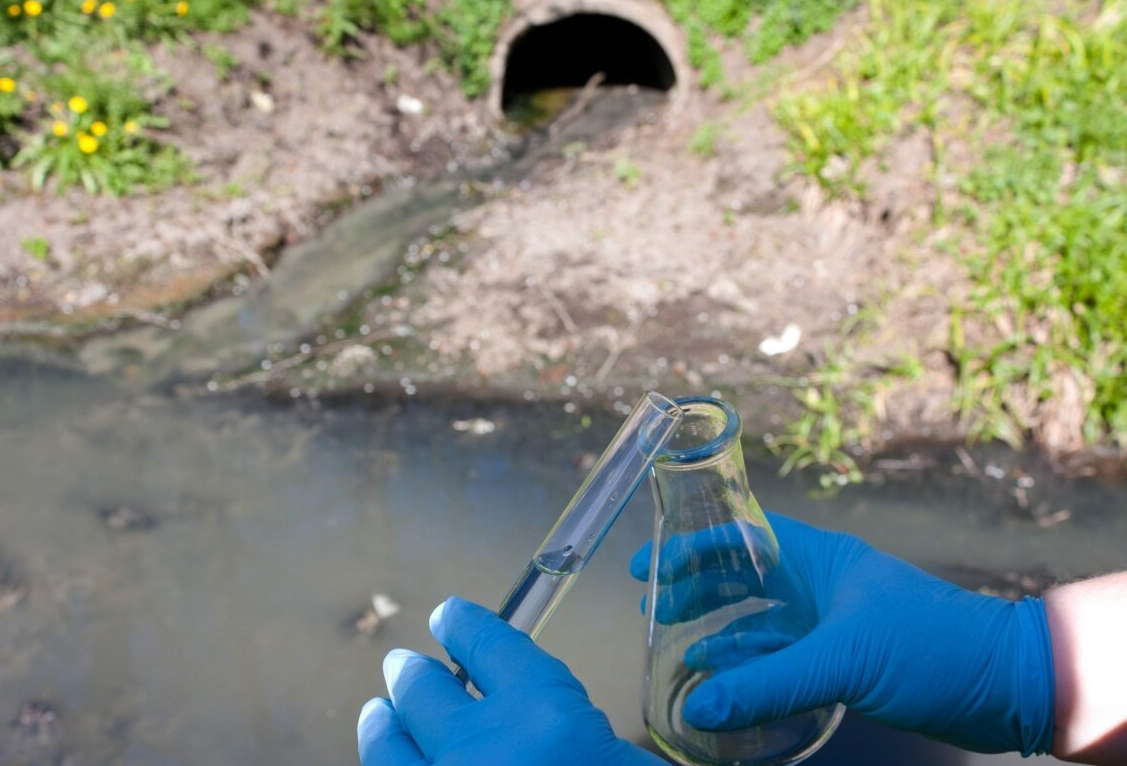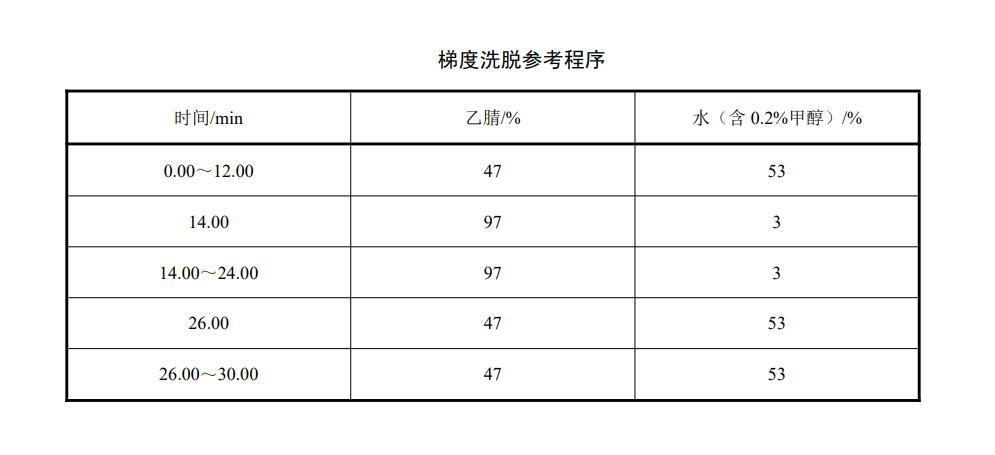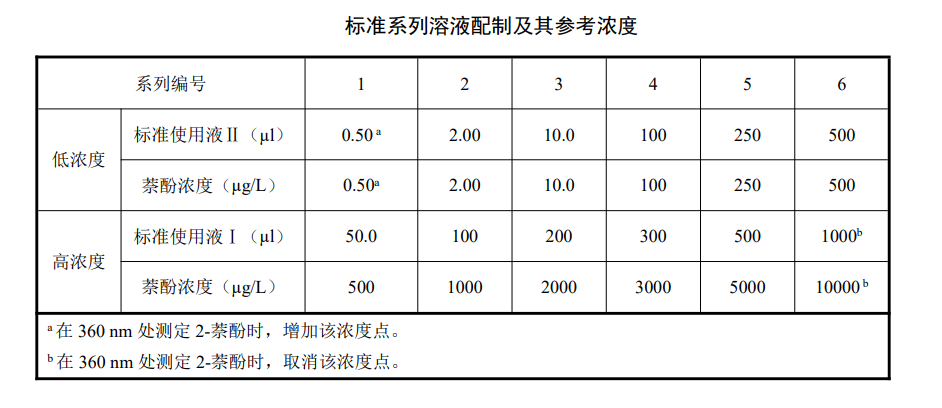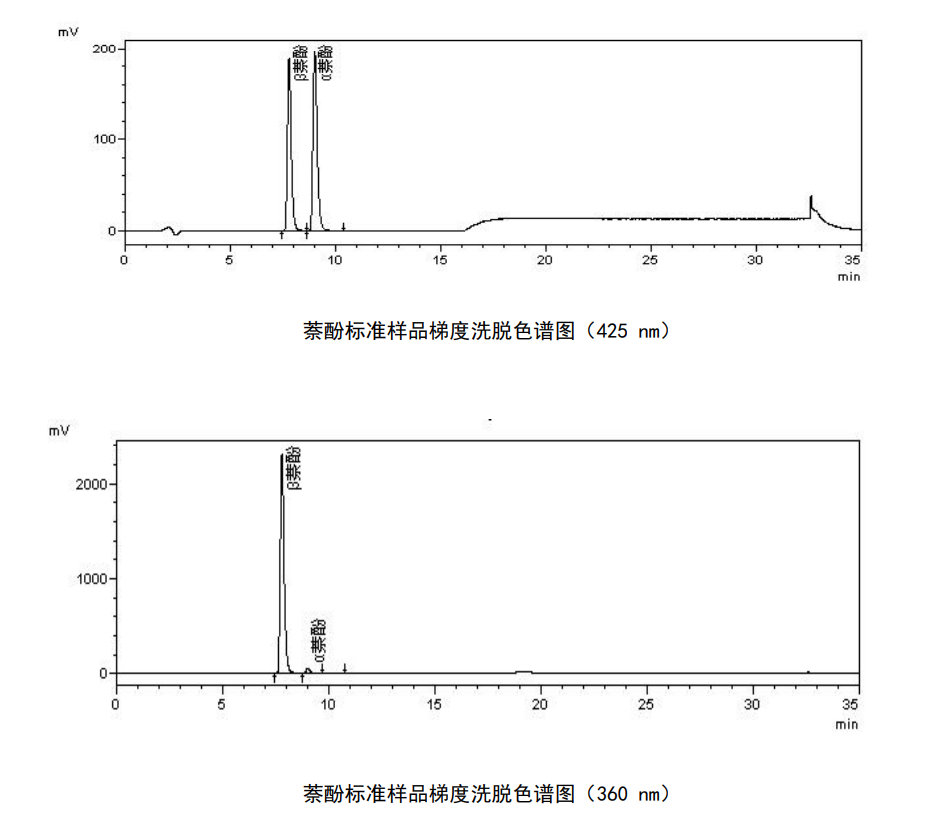The principle of using high performance liquid chromatography to detect the content of naphthol in water is to extract a certain amount of acidified sample (pH=1-2) with a C18 solid phase extraction column, elute with methanol, and the naphthol in the eluent is liquid. After chromatographic separation, it was detected with a fluorescence detector. Qualitative by retention time, quantitative by external standard method. This method can be used for the determination of naphthol in surface water, domestic sewage and industrial wastewater. When the sampling volume is 50ml, the eluent volume is 10.0ml, and the injection volume is 10.0ul, at the emission wavelength of 425nm, this method determines The detection limit of 1-naphthol and 2-naphthol are both 0.3ug/L, and the lower limit of determination is 1.2ug/L; at the emission wavelength of 360nm, the detection limit of this method for the determination of 2-naphthol is 0.06 ug/L, the lower limit of determination is 0.24ug/L.

Test reagents and materials
1. Acetonitrile (CH3CN): liquid chromatography pure.
2. Methanol (CH3OH): liquid chromatography pure.
3. Hydrochloric acid: ρ(HCl)=1.18g/ml.
4. Ascorbic acid (C6H8O6).
5. 1-Naphthol: w(C10H7OH)≥99.5%.
6. Naphthol mixed standard stock solution: ρ≈1000mg/L.
Weigh 0.10g (accurate to 0.0001g) of 1-naphthol and 2-naphthol respectively in a 100 ml beaker, add 100 mg of ascorbic acid (5.4), dissolve with a small amount of methanol (5.2), transfer to a 100 ml volumetric flask, use Dilute to the mark with methanol and mix. Distributed in brown sample bottles, sealed and refrigerated below 4°C in the dark, it can be stored for 3 months.
Commercially available certified standard solutions can also be purchased and stored according to the requirements of the standard solution certificate.
7. Naphthol mixed standard solution I: ρ=100 mg/L;
Measure an appropriate amount of naphthol mixed standard stock solution in a 10 ml volumetric flask, dilute to volume with methanol, and mix well. Distributed in brown sample bottles, sealed and refrigerated below 4°C in the dark, it can be stored for 3 months.
8. Naphthol mixed standard solution II: ρ=10.0 mg/L;
Measure 1.00 ml of Naphthol Mixed Standard Use Solution I (5.8) in a 10 ml volumetric flask, dilute to volume with methanol (5.2), and mix well. In a brown sample bottle, sealed and refrigerated below 4°C away from light, it can be stored for 3 months.
9. Hydrochloric acid solution 1+1.
10. Hydrochloric acid solution: c=0.01mol/L.
Measure 1.8ml of hydrochloric acid solution and dilute to 1000ml with water.
11. Solid phase extraction column C18: the packing is octadecyl-bonded silica gel, 500mg/6ml.
12. Microporous membrane: 0.45um, organic phase.
Instruments needed for testing
1. High performance liquid chromatograph: equipped with multi-channel fluorescence detector.
2. Chromatographic column: 250 mm (length) × 4.6 mm (inner diameter) × 5 µm (particle size), the packing is octadecyl-bonded silica gel (C18) or other equivalent liquid chromatography columns.
3. Brown sampling bottle: 250ml or 500ml screw cap glass bottle or ground mouth bottle with Teflon liner.
4. Amber vials: 2 ml, 10 ml or 50 ml screw cap glass vials with teflon liners.
5. Air-tight glass syringe: 5 ml or 10 ml, used with microporous filter membrane (5.13).
6. Solid phase extraction device.
Preparation of water samples for testing
Fix the C18 solid-phase extraction column on the solid-phase extraction device, activate the solid-phase extraction column with 9 ml of methanol and 9 ml of hydrochloric acid solution in sequence, and keep the column head soaked all the time. Equilibrate the sample to room temperature, shake well, measure 10.0 ml-50.0 ml of sample (according to the content of the target compound in the sample, the sampling amount can be appropriately increased or decreased) into the sample bottle, and then pass the sample at a flow rate of 3-4 ml/min extraction column. Just before the column packing is exposed to air, rinse the sample bottle twice with 5 ml of water, transfer the washing liquid to the column, discard the effluent, and squeeze out or dry the water in the extraction column under pressure. Elute with 10.0 ml methanol, receive the eluent, close the piston after the initial eluent flows out, and soak the solid phase extraction column for at least 5 minutes. Open the stopcock, collect all the eluates in a 10ml brown sample bottle, shake well, filter with a microporous membrane, and wait for the test.
Water sample testing steps
Instrument Reference Conditions
Mobile phase: acetonitrile/water (containing 0.2% methanol) = 47/53; flow rate: 1.2ml/min; injection volume: 10.0ul;
Column temperature: 35℃; Detector: Fluorescence detector; Excitation wavelength: 228 nm;
Emission wavelength: When measuring 1-naphthol and 2-naphthol at the same time, choose 425nm, 435nm or 450nm; when only measuring 2-naphthol, choose 360nm, 350nm. Use one of the wavelengths as the detection wavelength and the other as the auxiliary qualitative wavelength.

Preparation of standard series
Take an appropriate amount of Naphthol Standard Use Solution II or Standard Use Solution I in a 10ml brown volumetric flask, dilute with methanol to prepare a standard series with at least 5 concentration points that can cover the concentration range of the water sample. For the preparation of standard series solutions and their reference concentrations, see the table of solution preparation and their reference concentrations.

Establishment of standard curve
According to the reference conditions of the instrument, the standard series of solutions were sequentially injected from low concentration to high concentration, and the target compounds were separated and detected, and the retention time and peak height were recorded. Take the mass concentration (ug/L) of the target compound in each standard series solution as the abscissa and its corresponding peak height as the ordinate to establish a standard curve.

Test water samples
The prepared water samples can be tested according to the same instrument conditions as in the establishment of the standard curve, and according to the preparation steps of the water samples.
Qualitative Analysis
Qualitative based on retention time, or based on the comparison of the peak height ratio of the target compound in the sample under different emission wavelengths with that of the standard water sample (the relative deviation should be ≤5%) to assist in the qualitative determination. If necessary, it can be confirmed by liquid chromatography-mass spectrometry.
quantitative analysis
Quantitative with external standard method. The response value of the target compound in the sample should not exceed the upper limit of the standard curve. Otherwise, the water sample should be properly diluted before extraction or the sampling amount should be appropriately reduced, and the dilution should be multiplied during the calculation.
Finally, the result is obtained by the corresponding calculation formula.
Interference and cancellation
1. Basic organic compounds such as naphthylamines in water samples are extracted by solid phase extraction under acidic conditions (pH=1~2), and exist in the water phase in the form of salt ions, which are not adsorbed by C18 solid phase extraction column. Does not interfere with the determination of naphthol.
2. Polycyclic aromatic hydrocarbons in water samples, under the conditions specified in this standard, have very low response values, and generally do not interfere with the determination of naphthol.
3. Other acidic and neutral organic compounds that respond on the fluorescence detector may interfere with the determination of naphthol. The resolution can be improved by changing the ratio of the mobile phase, or the measurement can be performed at a relatively non-interfering detection wavelength to avoid interference. .
4. In order to avoid the penetration of the solid phase extraction column, the total content of the target compounds in the water sample should generally not exceed 200µg. Otherwise, the water sample should be properly diluted before extraction or the sampling volume should be appropriately reduced.
5. For water samples with complex matrix and unknown organic content, in order to avoid breakthrough, two solid phase extraction columns can be used to extract the same water sample of different volumes. For example, extract 10.0ml and 20.0ml respectively. When the measurement result of the latter is lower than 20% of the former, it means that the adsorption capacity of the latter has reached saturation. It is necessary to appropriately reduce the sampling amount or dilute the water sample before solid-phase extraction.
6. For clean water samples, it can also be filtered by a microporous membrane and then injected directly.



